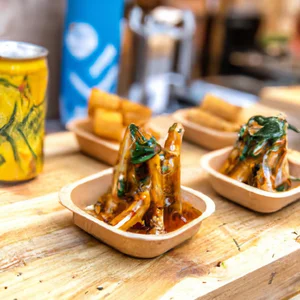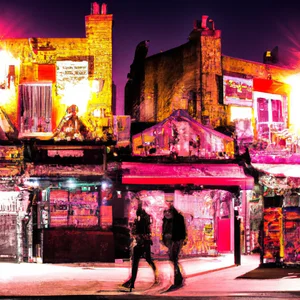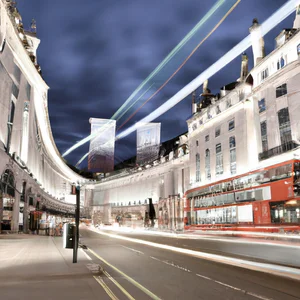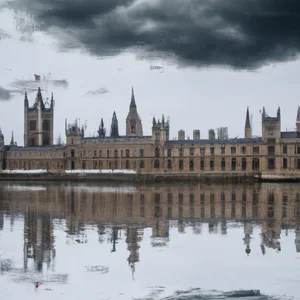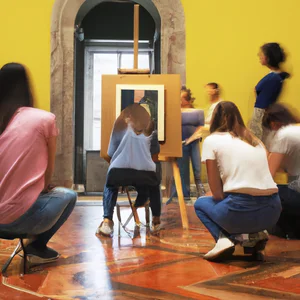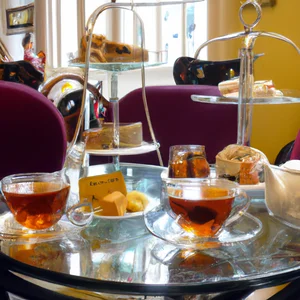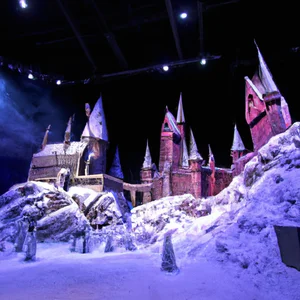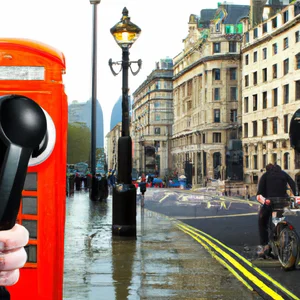Book your experience
Museum of London: journey through the history of the capital from Roman times to today
The Museum of London is a truly fascinating place, where you can take a real leap in time, from Roman times to the present day. It’s as if every corner told a story, and when I went there last time, I felt a bit like an explorer, ready to discover the secrets of this great city.
Yes, in short, it is a journey that takes you for a walk in the past. For example, if you stop to look at Roman artifacts, you realize how different life was back then. It’s kind of like comparing an old black and white movie to today’s superheroes, you know? And then, there are the pieces that tell of medieval London, with its slightly mysterious atmosphere, almost like a horror film. I remember seeing armor that looked like something out of a tale of knights and dragons, and wondering what it was really like to live in those times.
The museum is huge, so be prepared to get lost in the rooms and galleries. Every time you think you’ve seen it all, another exhibit pops up and grabs you. I think it’s a perfect place for those who want to know more about culture and history, but also for those who, like me, simply love to browse. Maybe I’m not a great history expert, but I like discovering new things.
And let’s not forget the latest details! There is also a section dedicated to the most iconic events of modern London, such as the 2012 Olympic Games. It is incredible to think about how this city has been able to reinvent itself over the years. There is a sort of energy that you breathe, a combination of past and future that is truly unique.
In short, if you happen to be in London, don’t miss the opportunity to visit this museum. You may not come away with all the information in your head, but you will certainly have plenty of stories to tell, and who knows, maybe even some personal anecdotes to add to your experience. Well, I’ve found it to be a place worth visiting, even just to browse around a bit!
From Roman Origins: Explore the foundations of London
A journey through time through the stones
I vividly remember my first visit to the Museum of London, when, walking through the gallery dedicated to the capital’s Roman origins, I found myself faced with an ancient brick wall, part of the fortifications of Londinium. The stones, worn by time, told stories of Roman soldiers, traders and citizens, and it is as if I could hear their footsteps echoing in the past. This encounter with history made me reflect on how London, now a bustling metropolis, was built on such rich and complex foundations.
Practical information
The Museum of London is located in the heart of the capital, easily accessible by tube (Barbican station) or bus. Admission is free, but some special exhibitions may require a ticket. I recommend you check the official website Museum of London for updated information on opening hours and current exhibitions.
An insider tip
If you want a truly unique experience, I recommend taking one of the museum’s “Behind the Scenes” guided tours, where you can explore areas normally closed to the public and discover fascinating details about the conservation of the artifacts. On these occasions, curators share little-known anecdotes that can greatly enrich your understanding of London’s Roman history.
The cultural and historical impact
Londinium wasn’t just a military outpost; it was a crossroads of cultures, trade and innovation. Its foundation laid the foundation for the development of one of the most influential cities in the world. Traces of that past can be found not only in physical structures, but also in street names and archaeological remains scattered throughout the city.
Sustainable tourism practices
In an age where sustainable tourism is key, the Museum of London is committed to preserving and showcasing cultural heritage responsibly. Participating in events and activities that promote local history is one of the best ways to support the museum and the surrounding community.
An immersive experience
As you explore the Roman galleries, let your senses be enveloped in the atmosphere of the past: observe the soft lights, listen to the stories told and immerse yourself in the evocative scents of the objects on display. Every detail, from Roman coins to ceramics, brings you closer to a time when London was just starting to take shape.
An activity not to be missed
Don’t miss the opportunity to visit the famous “Roman London” in London, where you can see some of the most significant archaeological remains, such as the Temple of Mithras and the London Wall. This walk will allow you to connect the history of the museum with the current urban landscape.
Myths and misconceptions
A common myth is that London is just a modern city, with no ties to its past. In reality, every corner of London tells a story, and the Museum of London is the key to discovering how deep these connections are.
Final reflection
As you leave the museum, ask yourself: How has knowing that beneath my feet lies thousands of years of history influenced my perception of London? London’s Roman origins are not just a part of the past; they are the foundation on which the modern capital stands, and every visit to the Museum of London is an opportunity to reconnect with those roots.
Interactive routes: experiencing history through the senses
A journey through time
I remember the first time I visited the Museum of London. As I approached the entrance, a light rain fell, creating an almost mystical atmosphere. Upon entering, I was greeted by an explosion of colors and sounds, as if the past were coming to life around me. The smells of spices from the medieval era and the rustle of period clothing transported me to another era, making history tangible and alive. Every step was an invitation to explore not only what was, but how people lived, loved and fought in the beating heart of London.
Immersive experiences
The Museum of London offers a wide range of interactive tours that allow visitors to immerse themselves in the history of the capital. Through multimedia installations, it is possible to listen to stories of daily life, observe reconstructions of historical scenes and even touch objects that date back centuries. The exhibits are designed to stimulate the senses, making the experience not only educational, but also emotionally engaging.
Recent statistics indicate that the museum has increased visitor interest in its interactive exhibits, up 25% compared to previous years. This shows how technology can enrich our understanding of history.
An insider tip
If you are a history lover, don’t limit yourself to exhibitions alone: take part in one of the interactive workshops offered by the museum. Here, you can try your hand at creating a Roman mosaic or writing with vintage ink, fully immersing yourself in London’s historic culture. These activities are not only fun, but also offer a unique opportunity to learn by doing.
The importance of interactive history
Interactive history isn’t just a way to attract tourists; it is a way to preserve and transmit cultural heritage. These experiences help create an emotional connection between the visitor and history, allowing everyone to better understand the impact that historical events have shaped London today.
Sustainability and responsible tourism
The Museum of London is also committed to sustainability. By offering routes that encourage the use of public transport to reach the museum, they promote responsible tourism. Furthermore, the museum has adopted eco-friendly practices to reduce its environmental impact, making the visit not only a journey through time, but also a step towards a more sustainable future.
An experience not to be missed
If you want to experience London’s history in an authentic way, I recommend you don’t miss the “London: The Inside Story” exhibition, which explores the personal stories of those who have lived in this city over the centuries. Through objects, photographs and narratives, you will have the opportunity to connect with the past in a unique way.
Myths and misconceptions
A common misconception is that visiting a museum should be a boring experience, made up only of reading and static observations. Indeed, the Museum of London demonstrates that history can be engaging and vibrant, dispelling the myth that the past is distant and unattainable.
A final reflection
After exploring the interactive history of London, I invite you to reflect: how is your daily life influenced by the historical events around you? Every corner of London tells a story, and now you have the tools to listen to it. Which piece of history struck you the most and how will you take it with you?
Surprising Collections: Hidden Treasures from the Museum of London
An unforgettable experience
I still remember the moment I crossed the threshold of the Museum of London, a rainy afternoon that seemed to promise little good. But inside, unexpected surprises awaited me. As I explored the galleries, I came across a small collection of everyday objects dating back to Roman times, including a simple terracotta vase. But it wasn’t a normal vase: it was a piece of history that told me about the rituals and customs of ancient London, then known as Londinium. This close encounter with the past made me realize how fascinating and profound the connection between objects and the stories they tell can be.
Discover the Museum of London
Located in the heart of the Barbican, the Museum of London is home to one of the capital’s richest collections, with over 7 million objects spanning London’s history, from its Roman origins to the present day. Among the most surprising treasures are the remains of an ancient Roman port, an Egyptian mummy and a reproduction of the famous London sign in medieval times. Each object is a piece of the puzzle that makes up the story of a constantly evolving metropolis.
To visit the museum, it is advisable to book in advance, especially during busy periods. The good news is that entry is free, but some temporary exhibitions may require a ticket. For up-to-date information, visit the official [Museum of London] website (https://www.museumoflondon.org.uk).
An insider tip
If you want a truly unique experience, don’t miss the section of the museum dedicated to “Londoners who made history”. Here you will find portraits and objects of lesser-known figures, such as women who fought for civil rights. But the real gem is the chance to participate in special events, such as nighttime guided tours, where history comes to life in a completely new light.
The cultural impact
The Museum of London is not just a repository of historical objects; it is a place that celebrates London’s cultural diversity. Through its collections, it tells how the capital has been shaped by countless cultures, helping to make it one of the most vibrant centers in the world. The history of migrants, for example, is highlighted in many exhibitions, underlining their crucial role in shaping the city’s identity.
Responsible tourism
In an era where sustainability is key, the museum promotes responsible tourism practices, encouraging visitors to respect and protect cultural heritage. They also offer educational workshops on how to reduce your environmental impact, making your visit not only informative, but also educational.
An activity not to be missed
In addition to exploring the permanent collections, I recommend taking part in one of the storytelling sessions held regularly in the museum. These sessions offer an immersive way to immerse yourself in the stories of London, told by expert storytellers who know how to capture attention and imagination.
Myths to dispel
A common misconception is that the Museum of London is only for history buffs. In reality, the museum is an experience for everyone, with interactive displays and activities designed to engage visitors of all ages. Don’t be fooled into thinking it’s a boring place; every corner is full of life and surprise.
A reflection
After my visit, I asked myself: How can we continue to tell London’s story in a way that respects and celebrates its diversity? This question opened my mind to new perspectives and inspired me to explore the city further . And you, what stories will you take home after a visit to the Museum of London?
A walk through time: the evolution of the capital
A personal journey through the streets of London
The first time I set foot in London, I got lost in the streets of Southwark, immersed in the frenzy of a local market. While enjoying a slice of artisanal apple pie, I looked up and saw an ancient red brick building, which seemed to tell stories of centuries past. That sight inspired me to explore not only the capital’s present, but also its Roman and medieval roots, a journey that led me to discover how London has grown and transformed over the centuries.
The architectural and cultural evolution
London is a city that never ceases to amaze. Its Roman origins, dating back to 43 AD, are still visible in some areas, such as the site of Londinium. Today, walking along the banks of the Thames, you can admire the imposing Tower Bridge, the modernity of the Shard and the historicity of the Tower of London, almost as if wanting to narrate a dialogue between past and present. According to the Museum of London, the capital has undergone numerous architectural and social changes, reflecting the influences of invaders, monarchs and migrants.
An insider tip
If you want a less conventional experience, I recommend visiting the Londinium Museum, a little gem hidden below street level, where you can see Roman artefacts and discover the daily life of that era. This museum often goes unnoticed, but offers an authentic perspective on life in London during Roman times.
The cultural impact of history
The transition from Roman Londinium to medieval London and then to the modern era has profoundly influenced the city’s culture and identity. The fusion of traditions, languages and cultures has created a vibrant, multi-ethnic metropolis. Every corner of London tells stories of resistance and innovation, testifying to how the various waves of migration have enriched the cultural heritage of the capital.
Sustainable tourism
In the current era, it is crucial to consider sustainable tourism practices. Many museums and historic sites, such as the Museum of London, are taking initiatives to reduce their environmental impact, such as the use of renewable energy and recycling programs. Visiting these places not only enriches you culturally, but also contributes to more responsible tourism.
An experience not to be missed
Don’t miss the opportunity to participate in one of the historical walks organized by local guides. These guided experiences will take you through hidden alleyways and reveal fascinating anecdotes about London’s history, giving you an emotional connection to the city.
Myths and misconceptions
It is common to think that London is just a modern and frenetic city, but the truth is that its roots lie in a rich and complex past. Many visitors are unaware of the importance of history Roman and medieval, thus losing the opportunity to fully appreciate its evolution.
Final reflection
Every time I walk the streets of London, I ask myself: how much of our present is influenced by the choices of the past? This city is a constant reminder to explore our origins and understand how history can shape our future. I invite you to reflect on how your personal history is intertwined with that of this extraordinary capital.
Stories of everyday life: the London of past centuries
An immersion in the past
I vividly remember the first time I walked the streets of Smithfield, an old meat market that has seen centuries of history. As I observed the remains of medieval buildings and listened to the chatter of the vendors, I felt transported back in time, imagining the daily life of Londoners in the 1500s. That moment made me realize how London’s history is not just made up of grandiose events, but also of simple stories that tell of ordinary people.
Daily life in the heart of London
To understand the London of the past, it is essential to explore the places that shaped the daily lives of its inhabitants. The markets, churches and taverns were the hub of the community. For example, Borough Market, founded in 1014, is not just a place to find modern culinary delights, but a landmark that reflects changes in the city’s food and social habits.
Visit the Museum of London to immerse yourself in the everyday stories of Londoners through the ages. The section dedicated to domestic life offers an authentic look at everyday objects, from clothes to tableware, showing how people lived, worked and related to each other.
An insider tip
If you want a unique experience, I recommend taking one of the thematic guided tours organized by local historians. These visits offer the opportunity to discover hidden corners of London, such as the medieval streets of Borough or the stories of the historic taverns of Fleet Street, where journalists and men of letters gathered to discuss and write.
Cultural impact
These elements of daily life not only highlight the habits and traditions of an era, but also offer us a perspective on the resilience of the population. The London we know today is the result of centuries of adaptation, change and cultural influences that have shaped its identity.
Responsible tourism
When exploring these historic places, consider sustainable tourism practices. Choose to walk or use bicycles to get around, thus helping to maintain the environment and reduce the impact of tourism on the city. Many of the historic markets also offer local and organic produce, allowing you to support area producers.
An experience not to be missed
Don’t miss the opportunity to visit St. Bride’s Church, known as the church of journalists. Its history dates back to 600 AD. and its architecture is a wonderful example of how ancient London has evolved over time. Climbing its tower will give you a panoramic view that visually tells the story of the city’s transformation.
Myths and misconceptions
A common misconception about London in the past is that it was an ugly and unhealthy place, dominated by poverty. Although there were dark times, daily life was often vibrant and culturally rich, with festivals, markets and celebrations enlivening the streets.
Final reflection
As you get lost in the stories of London’s daily life, ask yourself: what stories remain unknown to us, hidden within the walls of this thousand-year-old city? The next time you explore London, bring with you the curiosity to discover the stories of those who are who came before us and how their lives have influenced the present.
Forgotten culture: the role of migrants in history
When I first stepped into Brick Lane, the spicy scent of curries and the sound of multilingual voices enveloped me like a warm hug. This lively street, famous for its restaurants and markets, is much more than just a gastronomic hub; it is a symbol of London’s rich and varied migration history. As I walked, I felt the pulse of daily life, a rhythm that tells stories of hope, struggle and resilience, all woven into the fabric of this great capital.
A journey through migratory history
London has been a crossroads of cultures for centuries, since the Romans founded Londinium in 43 AD. up to the present day. Today, over 37% of London’s population is made up of people born abroad. This cultural mosaic has shaped not only the urban landscape, but also its culture, its economy and its traditions. Migrant communities have brought with them skills, flavors and ideas, enriching the capital in ways that are often underestimated.
According to the Museum of London, migrant stories are an integral part of the city’s historical narrative. Exploring these stories provides a better understanding of contemporary London identity and how global influences have shaped its development.
An insider tip
If you want to immerse yourself in this forgotten culture, take part in one of the many Walking Tours that focus on London’s migration history. A particularly interesting tour is one that winds through the streets of Southall, a neighborhood known for its vibrant Indian community. Here, you will not only be able to taste delicious typical dishes, but also listen to stories of migrants who have contributed to making London what it is today.
Cultural impact and sustainable practices
Migrants have not only influenced London’s culinary and artistic culture, but have also contributed to sustainable tourism practices. Many of their business activities, from street markets to cultural initiatives, are built on principles of sustainability and inclusion. By choosing to support these businesses, tourists can contribute to a more just and responsible economy.
The London of migrants
Contrary to a common misconception that London is a place of elitism and homogeneity, the truth is that the capital is a reflection of a wide range of experiences and identities. The history of migrants is often overlooked in traditional tours, but it is fundamental to understanding the social fabric of the city.
Final reflection
As you venture through the streets of London, take a moment to reflect: what story does each corner of this city tell us? The next time you taste an ethnic dish or listen to a foreign language, ask yourself what journey brought that flavor or sound to you. London is an open book of migration stories, and each visit is an opportunity to discover a new and fascinating chapter.
Sustainability in museums: responsible tourism in London
A personal experience
I vividly remember my first visit to the Museum of London, where, in addition to exploring the historical wonders of the capital, I was struck by a surprising initiative: an exhibition dedicated to sustainability. As I looked at the reconstruction of an ancient artisan workshop, the curator told me how the museum was adopting eco-sustainable practices, from reducing waste to using recycled materials for exhibitions. This approach not only valued cultural heritage, but also educated visitors about the importance of preserving our environment.
Practical and up-to-date information
In recent years, London has made great strides in promoting responsible tourism. The Museum of London, for example, has implemented sustainable management policies to reduce its own environmental impact. Opening hours have been extended, allowing visitors to explore at less crowded times, while the museum’s restaurant offers dishes prepared with local and organic ingredients. For those who wish to find out more, the museum’s official website Museum of London provides updates on ecological activities and initiatives.
Unconventional advice
Here’s a little-known tip: take advantage of the guided bike tours that run through the heart of London. These experiences will not only lead you to discover hidden corners of the city, but they are also a fantastic way to reduce your carbon footprint, allowing you to explore actively and responsibly. Some companies, such as Bicycle Hire London, offer tours that focus on sustainability and urban history.
The cultural and historical impact
The concept of sustainability is not new to London; has its roots in the history of the city itself. Since Roman times, Londoners have adapted their environment to the challenges of the time, and today this spirit of adaptation is more relevant than ever. Growing awareness of environmental issues has led to renewed interest in the capital’s cultural and architectural heritage, encouraging reflection on our role in the balance between progress and conservation.
Sustainable tourism practices
When visiting London, consider adopting sustainable practices such as:
- Use public transport or bicycle to get around.
- Choose restaurants that support local and organic production.
- Participate in events and activities that promote environmental awareness.
An activity worth trying
I recommend taking part in a sustainable crafts workshop, where you can learn traditional techniques using recycled materials. These experiences not only enrich your cultural background, but also allow you to actively contribute to the sustainability of the local community.
Common myths
One of the most widespread myths is that sustainable tourism involves sacrifices in terms of experience. Conversely, exploring London responsibly can enrich your visit, giving you the opportunity to discover authentic stories and deeper connections to the city.
A final reflection
As you prepare to discover London, ask yourself: How can I help preserve the beauty of this historic capital during my visit? Every small action counts and can make a difference in ensuring that future generations can enjoy the cultural and environmental richness of London.
Local Events: Participate in unique exhibits and activities
An experience that involves all the senses
Imagine finding yourself in the beating heart of London, surrounded by stories that intertwine like the threads of a tapestry. One of the first times I visited the Museum of London, I came across a temporary exhibition dedicated to life in the Victorian period. The vibrancy of the images, the smell of old photographs and the background sounds that evoked street life transported me back in time. This is the power of the local events that the museum offers: not just static displays, but living experiences that engage and inspire.
What to expect from the events
The Museum of London is not just a container of historical artefacts; it is an active cultural center that hosts a variety of events, from conferences to workshops to live performances. For example, during the month of October, the museum organizes the Londinium Festival, an event that celebrates London’s Roman history with family activities, historical re-enactments and special guided tours. You can find further information on the museum’s official website and on social channels to stay updated on the latest activities.
An insider tip
If you want a truly unique experience, take part in one of the museum’s late openings. During these evenings, you can enjoy the exhibitions in a more intimate atmosphere and there are often special events with live music or artistic performances that are not found during the day. A real immersion in London culture!
The cultural impact of events
These events not only enrich the visitor experience, but also strengthen the connection between the community and the city’s history. Through interactive activities, the museum invites Londoners and tourists to rediscover their roots and engage with stories that might otherwise remain forgotten. This inclusive approach helps keep historical memories alive, making each event an opportunity to explore London in a new light.
Responsible tourism practices
Attending local events at the Museum of London is also a way to support responsible tourism practices. The museum promotes initiatives that encourage community involvement and environmental education, contributing to sustainable tourism that respects the city’s cultural and natural heritage.
An invitation to explore
If you are a history buff or simply curious to discover more about the British capital, don’t miss the chance to attend one of these events. Whether you choose to immerse yourself in an exhibition or take part in a hands-on workshop, each experience will offer you a unique window into life in London past and present.
Final reflection
Have you ever wondered what stories hide behind the monuments and streets you pass through every day? Every event at the Museum of London is an opportunity to discover the vibrant fabric of the city, rich in forgotten narratives. The history of London is not just a chronicle; it is an invitation to explore, understand and, above all, live. Will you be ready to answer this call?
An unconventional tip: explore lesser-known areas
When I visited the Museum of London, I happened to pass by a small room that didn’t seem to attract visitors’ attention. It was a quiet corner, with a handful of people lingering at information panels. Curious, I decided to enter and, to my surprise, I discovered a fascinating reality: an exhibition dedicated to the daily lives of London’s inhabitants through the centuries, a story that seemed to escape the great spotlight of the museum.
A hidden treasure
This lesser-known space offers an intimate insight into London life, with ordinary objects telling extraordinary stories. From antique kitchen utensils to clothing used in times gone by, each piece is a silent witness to lives lived. The amazing thing is that, just like an old photo album, these objects evoke emotions and memories, making the visitor feel part of a larger story.
A unique perspective
Often, we tend to visit only the most famous and crowded areas of a museum, but exploring the less frequented areas can reveal unexpected treasures. It’s a bit like discovering a small café hidden in a back street in London, where the true flavor of the city manifests itself in an authentic way. So if you’re at the Museum of London, don’t forget to check out these lesser-known areas; they could offer you a new perspective on London history and culture.
An insider tip
One tip that only an insider could give you is to visit the museum during the early hours of the morning or on weekdays. This way, you will have the opportunity to explore without the crowds and discover those details that often escape distracted eyes. Also, take advantage of the free guided tours that the museum offers; they are a great way to learn anecdotes and curiosities that would otherwise remain in the shadows.
The importance of these discoveries
Exploring lesser-known areas of the Museum of London is not only a way to enrich your experience, but also an opportunity to reflect on the cultural and historical impact of these objects. Each piece on display tells a story of resilience, innovation and change, helping to shape the identity of a cosmopolitan city like London.
Sustainable tourism practices
Furthermore, discovering these lesser-known corners is a way to practice responsible tourism. Supporting small exhibitions and visiting less crowded places helps spread the tourism impact, preserving the historical and cultural integrity of the city.
An experience not to be missed
If you’re feeling adventurous after visiting the museum, consider taking a walk around Smithfield, a less-traveled historic area famous for its meat market and historic buildings. Here, you can breathe in the authentic atmosphere of London and perhaps discover some local gems.
A final reflection
At the end of the day, every corner of London has a story to tell. Have you ever wondered what stories hide behind the places you visit? The next time you explore a museum or neighborhood, try to look beyond the surface and be surprised by what you might discover.
Changing London: how history shapes the present
A journey through time
I remember perfectly my first encounter with Trafalgar Square. As I walked among the tourists and street performers, the majesty of Nelson’s Column stood above me, like a silent guardian of ancient stories. I stopped to observe the life pulsating around me: the street vendors, the families enjoying a day in the sun, the young people taking selfies. In that moment, I realized that every stone in London tells a story, and that the past continues to influence the present in invisible but powerful ways.
The transformation of the capital
London is a constantly evolving city, where every corner reveals traces of a rich and complex past. Just a stone’s throw from Trafalgar Square, the Southbank neighborhood offers a prime example of how history can shape the future. Originally an industrial area, today it is a vibrant cultural centre, with theatres, art galleries and markets. This transformation is the result of conscious urban planning, which has been able to enhance history while keeping the essence of the place alive.
An insider tip
If you want an authentic experience, I recommend visiting Borough Market during opening hours, preferably on a weekday. This market is not only a place to buy fresh produce, but also a window into London’s food history. Here you can savor dishes that tell the stories of the different migratory groups that have helped shape the city’s culinary culture. Don’t forget to stop and chat with the vendors; each of them has an anecdote to share that will take you back in time.
Cultural impact and sustainable practices
London’s transformation is not just architectural; it is also cultural. The city embraces its multicultural roots, and initiatives such as London Borough of Culture celebrate the diverse identities that make up the urban fabric. In this context, sustainable tourism is becoming a fundamental pillar. Choosing to visit local shops and restaurants, use public transportation and attend community events not only enriches your experience, but also supports the local economy.
An experience not to be missed
An activity I highly recommend is a walk along the Thames Path, a path that runs alongside the river and offers unique views of the city’s historic and modern monuments. As you walk, take a moment to reflect on how London today is the result of centuries of change, from Roman origins to futuristic projects like the O2 Arena.
Myths to dispel
A common misconception is that London is just a grey, busy metropolis. In reality, the city is a mosaic of colors and cultures, with quiet corners and fascinating stories to discover. Many tourists focus on the iconic sights, but the real London is found on the streets less travelled, where every step reveals a fragment of its history.
A final reflection
As you continue to explore this extraordinary city, ask yourself: how can you help preserve and celebrate London’s history on your journey? Each visit is an opportunity to connect with the past and contribute to a sustainable future. London is not just a destination; it is a continuous journey through time and culture, which invites each of us to be part of it.

 Architecture and Design
Architecture and Design Cities and Regions
Cities and Regions Culture and History
Culture and History Events and Festivals
Events and Festivals Fashion and Shopping
Fashion and Shopping Food and Wine
Food and Wine Nature and Adventure
Nature and Adventure Unique Experiences
Unique Experiences


















